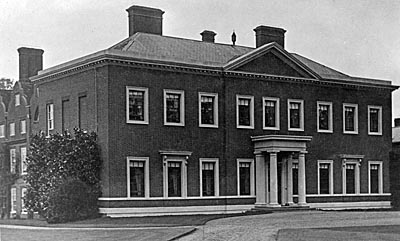 |
 |
|||
|
|
Haines Hill, in the liberty of Broad Hinton, is a large and architecturally important house in the parish of St. Nicholas Hurst, between Hurst Green and the border with Waltham St. Lawrence. The older portions are traditionally said to date back to the 1580s, but this seems unlikely. There may have been an early house on the site owned by the Hyde family from adjoining Hinton House, but the present Haines Hill appears to have been built around 1630 by Sir Francis Windebank, whose father, Thomas, had purchased the manor of Odes in the parish in the middle of Queen Elizabeth's reign. Sir Francis Windebank was Secretary of State in the reign of King Charles I and a friend of Archbishop Laud, who frequently visited him at Haines Hill, and records his visits in his Diary. Many of Windebank's letters, dated from Haines Hill, are extant. On one occasion, when he had to transact business of state at Haines Hill, owing to the fear of infection in London, the Council of State urged the establishment of a stage coach at Wokingham with good horses and guides to run to Hartford Bridge (at Elvetham in Hampshire) and Staines (Middlesex) during the secretary's residence in the country. The house was originally H-shaped in plan with two courtyards. The main entrance front faced west with a two-storey semicircular entrance porch and 'dutch' gables on the north and south wings, all of which still survive. Internally there is a long gallery similar to that at Bramshill (at Eversley in Hampshire) and other large houses of the period. In 1640, Sir Francis Windebank was arrested by order of the Parliament, but escaped and crossed to France, dying there six years later. His estates were sequestered and, soon after, his property in Hurst passed into the hands of Richard Bigg, a partisan of Oliver Cromwell, whose family originated in Wallingford. At Haines Hill is still preserved the pardon granted to Bigg by Charles II, permitting him to retain possession of his property in spite of his support of the Parliamentarian cause during the Commonwealth period. It is a beautifully inscribed document bearing a portrait of Charles in the left-hand top corner. The windows and walls of the ends of the long gallery were rebuilt in the Queen Anne style by Bigg's grandson, John, shortly after he inherited the property, as the date, 1716, on the outside testifies. Most of the internal ornamentation of the older portion is also of this Queen Anne date. Haines Hill and Odes remained with the Bigg family until about the middle of the 18th century. In 1736, the property was acquired by James Edward Colleton, who married Lady Ann Cowper, daughter of the first Earl Cowper. The front part of the house was built by James Edward Colleton in 1760, and some of the old account books relating to the building are still at Haines Hill. After the death of James Edward Colleton in 1790 with no direct heirs, Charles Garth, the grandson of his second cousin, succeeded to the estates of Haines Hill and took, in addition, the name of Colleton. Their common ancestor was the first baronet, Sir John Colleton, after whom Colleton County in South Carolina was named. Garth's family came from Devizes in Wiltshire and a number of manuscript volumes of his father's letters remain at Haines Hill. He was the Colonial Agent for that same US state, as well as Georgia and Maryland. On his death in 1818, he too had no male issue but left the property to his brother, Captain Thomas Garth RN, rather than his daughters. Captain Garth added the servants' wing about 1825. He died in 1841, and his son, Thomas Colleton Garth, DL, succeeded. He was the founder of the Garth Hunt and held his opening meet at Haines Hill on 8th November 1852, holding the mastership for half a century. He died in 1907, leaving the estate to his sister, Louisa Anne, the wife of Bertie Shiffner of Coomb Banks at Uckfield in Surrey, but she died three years later. The house then passed to her nephew, Captain William Charles Godsal, a younger brother of the inventor of the anti-tank rifle and one of the Godsals of Iscoyd Park on the English/Welsh border. Until the age of seventy-nine, William Godsal was a lifelong bachelor and, unfortunately, the house entered into a period of neglect as all spare cash was spent on funding the Garth Hunt. He died in 1938, leaving Haines Hill to his great nephew, Alan Anthony Colleton Godsal. The house suffered still further when it housed the Eaton House Preparatory School during the Second World War. Godsal, businessman and sometime Sheriff of Berkshire, was one of those names linked with Princess Margaret after her break with Peter Townsend. He restored the house and the estates fortunes, demolishing the Victorian service wing n 1963, emplying Prue Lane-Fox, Jean Munroe and David Mlinaric to work on the house interior and improving the grounds. He died in Barbados, where the family have always held extensive lands, in 2011. The estate is still held by the Godsals. Haines Hill is a
private residence. It is hidden by trees deep within the estate. |
|||
| © Nash Ford Publishing 2013. All Rights Reserved. | ||||



 Haines
Hill
Haines
Hill